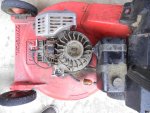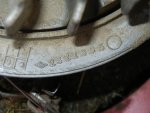The Nova II s a Hall Effect Trigger unit.
BAsically they are point eliminators.
They used the be a stand alone item connected to the coil.
But engine makers got greedy and put them inside the coil which now became an "ignition module" for 20 times the price of the coil & trigger units as descreet items.
I don't know if you can dig the old chip out of module and hook a Nova up to it but if yours is dead you have nothing to loose.
Novas and a few different Hall Effect Triggers are available from most mower shops
All of the aftermarket parts makes have one, Origon, Prime line, Stens, Rotary etc.
Some might even have several, one for 2 strokes & another for 4 strokes.
Atom Industries down here invented & marketed the units originally as the Atom Ignition Module and there were 7 of them each with different advance curves to suit different engines.
Every now & then some pop up when an old fart closes his shop and they dig down to the bottom of the obsolete parts bin.
Atom sold them from 1965 to 1996 when the patient ran out so every engine maker, made their own & they were no longer profitable.
They cost less than $ 1 to make but the rest of the original $ 20 went to packaging , distribution & retail profit, Atom wholesaled them for $ 5.
Some electronic geek shops have Hall Effect trigger kits which have programmable advance curves ( really a retard curve ) so you can try there as well.
The caveat is that Toro would have used its own distinctive advance so while your mower might run, the timing might be a little off
You will probably find the stand alone units at places that cater for old Lawn Boys, I think the OMC engines all used stand alone units.
If the unit has 1 terminal then you run a wire from the kill switch to the terminal & then to the coil
If it has 2 terminals and a metal body then kill wire to one & coil to the other
If it has 2 wires and a plastic body then it is ground to one & coil to the other
Rotary do Novas Item#8786
Stens do Mega Fire 440-465
Oregon don't have a name Part #33-053
Prime Line is Omega 7-01749
off Ebay
https://www.ebay.com/itm/ELECTRONIC-IGNITION-MODULE-REPL-John-Deere-M70114-Kawasaki-21119-2095-9334-/222502818720
And how to build one yourself for $ 5, probably $ 7 now days
https://www.electro-tech-online.com/threads/atom-diy-module.142530/
Could almost guarantee they all come out of the same factory in China.


